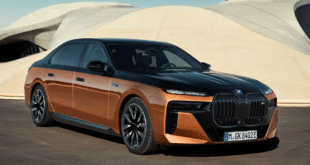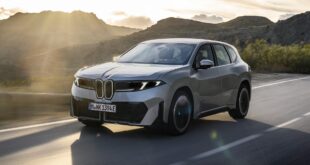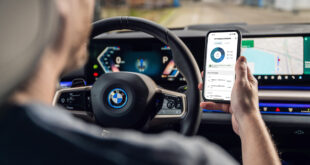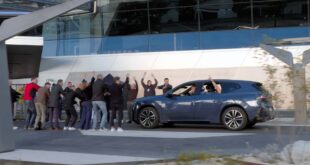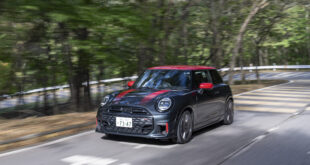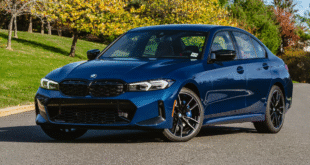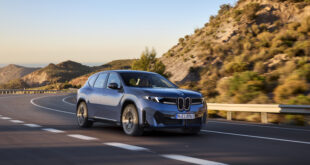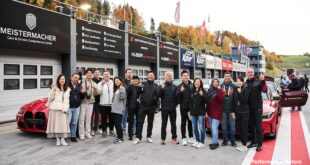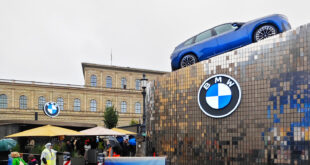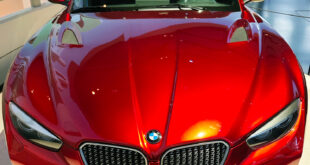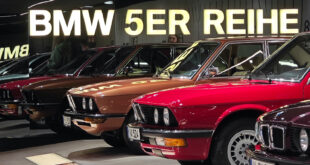Lastly, but by no means least, thanks to our very hardworking and resourceful friend at BMW, we had the privilege of sitting down with Mike Reichelt, Head of Neue Klasse at BMW. Our time together was brief, as Mr. Reichelt’s schedule was packed with interviews throughout the day. Still, even in that short conversation, he offered some insights into BMW’s boldest project to date. We only wish we had more time to dive deeper into the thinking of the man steering this new leap forward.

Q: “Let’s start with simple question about the name. Why did the team decide to bring back the Neue Klasse designation now, and not for any of the previous generations of cars that also introduced major technological leaps?”
A: “Yes, it actually started inside the company. People began calling this new generation Neue Klasse right from the beginning. The feeling was that it reminded us of a really big step in our history, a kind of quantum leap in technology and product development, like starting again with a white sheet of paper.
When we compared it, we said, yes, that’s exactly the right description for the leap we want to make. So we decided, this is the Neue Klasse. Just like the historical one, it marks a step into the future.
And it’s not only a communication topic for the outside world. Inside the company as well, it created a sense of pride, people are saying, this is the biggest step I can remember in my time at BMW. And you are part of it. That helped us build momentum around this quantum leap.
And what you’ve seen now (the iX3) is just the beginning, the first car in what will be a whole family. The next is the 3 Series sedan, the i3. The second key decision was not only to make this family uncompromisingly optimised for fully electric vehicles, but also to roll out the new technology across the rest of the portfolio.
We felt the step was so big that we had to modernise not only the purpose-built EVs, but also the current models, bringing in the latest digital content like the Panoramic iDrive. That’s why we chose the name Neue Klasse now, because it represents a leap forward for the entire brand, not just for one part of it.
Also, as you mentioned, after seeing the cars, it instantly made all the other models look like they belonged to a previous generation. That’s also true in the design language. When you look at the historic Neue Klasse, you can see certain elements we reused, for example, to create a completely new face. But it’s done in a modern way, with evolved light signatures. And yes, looking at this car, you can see how it modernises the whole portfolio.”


Q: “My next question is about product development cycles and the speed of bringing products to market. When we look at many of the new players in the automotive industry, adapting quickly to market trends seems to be a key factor in their success. So I want to ask: how fixed is BMW’s roadmap? Since the iX3 is just the first car, as you mentioned, are there plans to adjust the strategy along the way, or is the team fully convinced that this is the direction buyers want?”
A: “Yes, absolutely. We know technologies are evolving very quickly—whether in battery cells, digital content, or ADAS. Development didn’t stop with the launch of the Neue Klasse. With the Neue Klasse platform, we’ve designed the system to easily adapt to rapidly evolving technologies.
For example, we developed a battery pack that allows new cell formats or chemistries to be integrated without changing the rest of the platform. Many components are shared, for instance, the high-voltage system in the iX3 and the new i3 is the same, so when we upgrade one part, it can be rolled out across multiple models.
Software, for example, such as the ADAS stack and our collaboration with Momenta in the Chinese market, is also easy to integrate thanks to our “Super Brain” electronic architecture. We develop and manage the software ourselves, which allows us to implement a local tech stack for China, or any other market, quickly and efficiently.
When the new i3 arrives, it will have gained more digital power and third-party integrations. And as we roll out to the broader portfolio, we will continuously optimise, integrate, and expand these technologies. Software is truly at the heart of this flexibility.
Traditional car lifecycles, 7 to 9 years, are too long for rapidly evolving technologies. That’s why the Neue Klasse is designed to be future-proof, enabling us to integrate the fastest-moving innovations quickly and efficiently across the entire portfolio.”

Q: “Do you have any estimate for how long the Gen 6 eDrive technology is expected to last?”
A: “What we’ve prepared for is exactly that: when new cell technology becomes available, it can be integrated without requiring major changes to other components. For example, electric motors can be adapted, and the electronic systems can be updated without affecting the rest of the platform. This allows us to implement new technologies very quickly.”
Q: “Prepared for, say, solid-state batteries?”
A: “Yes, absolutely. We’re always looking at the latest technologies, including solid-state batteries. That said, when we look at what matters most to customers switching to fully electric vehicles, the key pain points are range, charging speed, and charging infrastructure. If a car already delivers good range and fast charging, other improvements might be less critical at this stage.
For us, the current generation addresses these core needs, so we don’t need to push for extreme range numbers right now. When it comes to solid-state or other next-gen battery technologies, it’s not just about increasing performance, it also has to reduce costs and remain safe.
We’ve already reduced costs dramatically with our current Gen 5 battery pack—by 40–50%—while improving range and charging speed. The next steps with newer technologies will focus on further cost reduction and safety, and once the technology is mature enough, we’re ready to integrate it.”
Q: “For the new battery, are there be advancements in managing heat and preventing thermal runaway issues?”
A: “Absolutely. That’s one of the main reasons we switched from prismatic cells to round cells, which also offer about 20% higher energy density. Changing the cell format allows us to fully control safety at every level, ensuring that even with higher energy density, the battery remains absolutely safe. We meet all safety requirements for both the individual cells and the overall battery pack.”
Q: “Just staying on the topic of generational progression for a moment: We know you were a key figure in the development of the outgoing cluster architecture. If you could put it into numbers, how different is the Neue Klasse compared with CLAR? Everyone hears the term “new platform,” but it’s quite abstract, how much is really new?”
A: “I think you have to look at the figures when you compare the current iX3. The predecessor was rear-wheel drive, now we have all-wheel drive. Back then, the WLTP range was 471 kilometers—now we are building for 800 kilometers. That’s a huge leap. We call it a “quantum leap.” And it’s only five years after the SOP of the previous model.
In terms of digital power, our “Super Brains” are 10 to 20 times faster than today’s electronic platforms. Efficiency has improved by about 20% compared to the predecessor. So, when you look at all of these things together, you see that it’s not just one single technology improving slightly, every technology makes a meaningful step. Taken together, it’s entirely new. That’s why we say it’s the beginning of a new era.
Some people ask, “What is the single innovation of the Neue Klasse?” The truth is, there isn’t one. You really need to experience the car to understand it. Take the panoramic iDrive, for example, you can project all relevant information in front of you in a spacious, clean interior. Combine that with the Super Brains, the electric drivetrain, and it feels like the car knows where you want to go. The initial moment of turning the steering wheel, sensational.
We also have amazing recuperation: more than 95% of all braking use cases are handled softly by the system, all the way to a complete stop. You hardly need to use the conventional brakes; they’re only for holding the car when it stands still. It’s so smooth that, if you close your eyes, you can’t even tell when the car has stopped. It’s an entirely new driving experience. And it’s not just on test tracks, out in normal everyday driving, it feels like the best BMW we’ve ever made.”

Q: “Coming back to the idea of brand loyalty and familiarity: at least from what we observe in Singapore, the EV models have been successful partly because they closely resemble the ICE models—essentially, electric twins. With this new iX3, which can no longer rely as strongly on familiarity, do you think there’s any risk of alienating longtime BMW customers? And on the other hand, what do you see as the strongest qualities of this new iX3 that can attract new buyers?”
A: “Yes, absolutely. One of the strongest qualities is the driving dynamics. For a Sports Activity Vehicle, the KPIs for electric driving are sensational—for example, we can charge 100 kilometers in just 150 seconds. It feels almost like refueling; every second is roughly one kilometer. This addresses some of the key pain points for customers transitioning to electrification.
Beyond performance, the in-car experience is also very real and engaging. From the very beginning, we made two critical decisions: first, to optimize Neue Klasse technology uncompromisingly for EVs, and second, to roll out this technology across the entire BMW portfolio. The step forward in both technology and design language is so significant that we couldn’t have a modern EV portfolio alongside an older ICE portfolio, it would have been inconsistent.
So, for example, the upcoming 3 Series will be available both as an EV on the Neue Klasse platform (the i3) and as an ICE model, but both will feature the same design language, the panoramic iDrive, and the latest digital content. This way, customers can choose to enter the electric world or stick with an ICE model while still enjoying the latest technology.
This is really a new era for BMW. We’ve never done anything like this before—rolling out Neue Klasse technology across 40 models in just two years. The first Neue Klasse model was challenging, but now the bigger task is integrating this technology across the full portfolio. We are convinced this is the right time to do it. With the breakthroughs in computing power, cell technology, and modern design language, it’s the perfect moment to implement such radical, modern advancements, something that the automotive industry usually approaches only step by step, rather than in groundbreaking leaps.”

Q: “Actually, I want to go back to the Neue Klasse name. How long ago was it?
A: “Initially, we started with the project name for the architecture—the ‘New Cluster Architecture’—but of course, customers aren’t interested in architecture. We sell experiences, the customer experience. During development, the idea came up that this represents such a big step in BMW’s history, maybe the biggest step since the original Neue Klasse, which laid the foundation for the current BMW portfolio. About a year after we started, around the end of 2021, we decided, both internally and for external communication, to bring back the Neue Klasse name.”
Q: “Was there any significant challenges that stand out as particularly difficult during the development of the Neue Klasse?”
A: “Yes, absolutely. It was a tough timeline. Developing such a quantum leap in technology meant venturing into areas where no one had gone before. We faced challenges in testing, integrating optimisation loops, and scaling up key components, like our Gen six electric drive, which required close collaboration with partners while still developing core expertise in-house.
The most critical part was identifying problems early in the process. Decisions made at the very beginning are the hardest to change later, so we had to ensure the Board of Management, project teams, and all experts were aligned from the start.
It required a combination of in-house expertise, writing code for the Heart of Joy, mastering vehicle integration, managing rapidly evolving technologies, and leveraging knowledge from partners and the supply chain. Integrating alternative technologies into a single architecture and a single car was intense and challenging.
But in the end, seeing all this latest technology come together in the car,and in such a broad, advanced way, made it all worthwhile.”
Q: “It does seem like a very short timeline for so many cars.”
A: “Yes, it does feel that way. Compared with some of our competitors, our development cycles are really short. And when you’re working on something entirely new, you have to ensure there are no mistakes, absolute quality is essential.
We test millions of kilometers with prototypes all around the world. Normally, you’d only do thermal development at this stage. Now, we’re rolling out technology much faster, but for a true quantum leap, we must guarantee quality. And that means extensive testing is unavoidable.”
Q: “Was there any public feedback along the way?”
A: “Yes, we did get feedback, but mainly with our vision cars. We tested our design internally within the Neue Klasse division, and what you see now is the final design.
The vision car acted as our last chance to make adjustments—it was our ultimate test to ensure we were heading in the right direction. Everyone I spoke with was very happy with how close the production design was to the vision.
We also tested the drive system, the ‘heart of joy,’ and all the other components, but those tests were done with prototypes and test engines, not with public-facing vehicles.”

Q: “Most people tend to feel a bit disappointed when they compare a concept car to the production version, since the concept always looks so striking. Was that something you noticed or considered during the development of the Neue Klasse?”
A: “This was really important for us. We made a promise with the Vision Car(s), and we wanted to ensure that the production version would deliver on that promise, and I think we’ve achieved that.”
Q: “Could there be a Neue Klasse Alpina?”
A: “That’s an interesting question. We’re starting now with the luxury segment, which is where the pinnacle of our design and technology is showcased. There might be options to expand to other segments later, but for now, the focus is on establishing Neue Klasse.”
Q: “I’m curious about the benefits of the ‘Heart of Joy.’ With all the discussion around it, will this system also be implemented in ICE cars? And how does it differ in terms of control and electronics compared with electric vehicles?”
A: “When you look at the Heart of Joy, it integrates the entire electronics, steering, drivetrain, and driving dynamics—something truly unique in the industry. It uses a fast central “super brain” to unlock the car’s full potential. To really experience it, you need a fully electric vehicle: electric motors react instantly, whereas combustion engines take time to engage, so you can’t feel the system’s full capabilities there.
For example, in the first M model on the Neue Klasse with an electric motor on each wheel, journalists noted it delivers an instant, connected sensation thanks to the Heart of Joy. The combination of rapid electric response and the fully integrated system creates a uniquely engaging driving experience.
I hope you love it!”
Q: “One last question just for fun, what are your top three BMWs, off the top of your head?”
A: “Most recently, I drove the first uncovered, iX3 on Friday night, it was fantastic, I love it. Also, in my history, I developed the i4, so that was my car before the iX3. And, of course, I love the 5 Series too.”
 BMW.SG | BMW Singapore Owners Community The Ultimate BMW Community – Established Since 2001
BMW.SG | BMW Singapore Owners Community The Ultimate BMW Community – Established Since 2001
